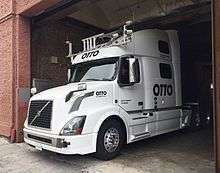Otto (company)
 | |
| Private | |
| Industry | Automotive, Technology |
| Founded | 2016 |
| Founders | Anthony Levandowski, Lior Ron, Don Burnette, Claire Delaunay |
| Headquarters | 737 Harrison, San Francisco, California, U.S. |
| Products | Self-driving kit for long-haul trucks |
| Parent | Uber |
| Website |
ot |
Otto is an American self-driving technology company established in January 2016 by Lior Ron and Anthony Levandowski. The San Francisco-based team, which has 90 employees as of August 2016, retrofits semi trucks with radars, cameras and laser sensors to make them capable of driving themselves. In August 2016 Otto was acquired by the transportation network company Uber. Co-founder Lior Ron has stated that Otto will have self-driving fleets of trucks on the road by early 2017.[1]
History
Otto was established in January 2016,[2] and is currently one of a new generation of automobile firms venturing into making self-driving vehicles.[3] The company was founded by Anthony Levandowski, who worked on the Google self-driving car project, and Lior Ron, who was a product lead on the Google Maps team.[2][4] Don Burnette, from Google’s self-driving car team, and roboticist Claire Delaunay are also co-founders.[5] The team as of August 2016 comprised 90 employees, with engineers from Google, Apple Inc., Tesla, Logitech, Stanford University and elsewhere.[2][6][7] The firm’s base is a garage in the South Market neighborhood of San Francisco.[2]
In August 2016 it was reported that Otto had been acquired by Uber, at an estimated cost of $680 million. Otto will stay independent from Uber, according to Lior Ron. Anthony Levandowski will continue heading up Otto, as well as being in charge of Uber's self-driving division.[1][8]
Technology

Otto doesn’t build its own trucks, instead focusing on making hardware kits which can be installed relatively quickly on trucks at service centers or factories.[9][10] The goal of the company over the next few years is for the technology to be used by truck drivers during long-haul drives to allow them to rest during the journey. This in turn would reduce the number of hours it takes for drivers to complete a journey by potentially being able to drive continuously,[11] and overcome the 11-hour legal restriction on manual driving.[12] As of August 2016, Otto has converted five Volvo 780 semis with self-driving technology, and is testing them on interstate highways.[4][7] They use similar technology to those developed by Google and Nissan, equipping the trucks with radars, cameras, and spinning laser sensors known as “Lidar.”[2] The automated technology makes driving more efficient, and would allow a truck driver to sleep while the truck is driving itself.[2] Levandowski has stated: "Our goal is to make trucks drive as humanly as possible, but with the reliability of machines."[4]
Safety
According to John Markoff of ‘’The New York Times,’’ Otto made the conscious decision to automate trucks rather than passenger vehicles because, “Nationally, trucks drive 5.6 percent of all vehicle miles and are responsible for 9.5 percent of highway fatalities.”[2] The need to make truck driving safer is one of the aims of the firm. Ron has been quoted as saying: "We want to get the technology to the point where it's safe to let the driver rest and sleep in his cabin and we can drive for him, exit to exit."[13] Eventually the trucks will be able to drive autonomously on the 220,000 miles of highways in the US,[4] though in some states such as California there may be regulatory obstacles.[2][4] The firm intends to collect safety data to demonstrate the benefits of the automated technology.[14] In an interview with Emily Chang of Bloomberg West, David Kirkpatrick, the CEO of Techonomy Media, stated that the public is far more likely to embrace trucks with automated driving than passenger vehicles due to the wide perception that trucks are driven dangerously by truckers.[11]
References
- 1 2 Griffith, Erin (19 August 2016). "Uber's $680 Million Gut-Punch to Google - The hard-charging startup just acquired the guy behind Google's self-driving car program.". Fortune.com. Retrieved 19 August 2016.
- 1 2 3 4 5 6 7 8 Markoff, John (17 May 2016). "Want to Buy a Self-Driving Car? Big-Rig Trucks May Come First". ’’The New York Times’’. Retrieved 8 August 2016.
- ↑ Griffith, Erin (23 June 2016). "Who Will Build the Next Great Car Company?". ’’Fortune’’. Retrieved 8 August 2016.
- 1 2 3 4 5 Liedtke, Michael. "Startup wants to put self-driving big rigs on US highways". Associated Press. Retrieved 8 August 2016.
- ↑ Kelly, Heather. "Google self-driving car vets take on automated trucks". CNN. Retrieved 8 August 2016.
- ↑ Yadron, Danny (17 May 2016). "Could self-driving trucks hit America's highways? This startup thinks so". ’’The Guardian’’. Retrieved 8 August 2016.
- 1 2 "Startup Otto Aims to Leapfrog to First in Self-Driving Vehicles With Big Trucks". Forbes. 1 August 2016. Retrieved 8 August 2016.
- ↑ Harris, Mark (19 August 2016). "How a robot lover pioneered the driverless car, and why he's selling his latest to Uber". The Guardian. Retrieved 19 August 2016.
- ↑ Ziegler, Chris (17 May 2016). "Google veterans head off on their own to work on self-driving trucks". ’’The Verge’’. Retrieved 8 August 2016.
- ↑ Kharpal, Arjun (17 May 2016). "Otto, a start-up by ex-Googlers to make trucks driverless, has launched". CNBC. Retrieved 8 August 2016.
- 1 2 "Will Autonomous Trucks Kill Jobs?". Bloomberg. Retrieved 8 August 2016.
- ↑ Bajpai, Prableen (2 June 2016). "Self-Driving Trucks Could Revolutionize The Industry". Nasdaq. Retrieved 8 August 2016.
- ↑ "Otto offers retro-fit driverless lorries". BBC. Retrieved 8 August 2016.
- ↑ "Creator of Google's first self-driving car launches truck startup (VIDEO)". ’’Silicon Valley Business Journal’’. 17 May 2016. Retrieved 8 August 2016.